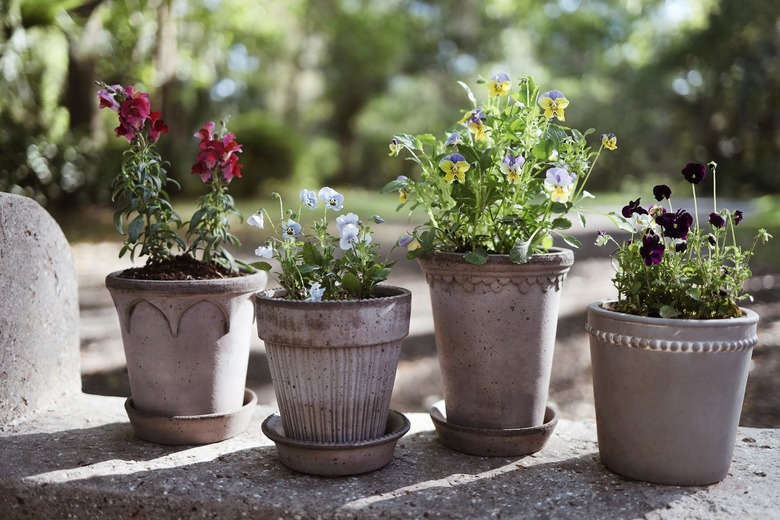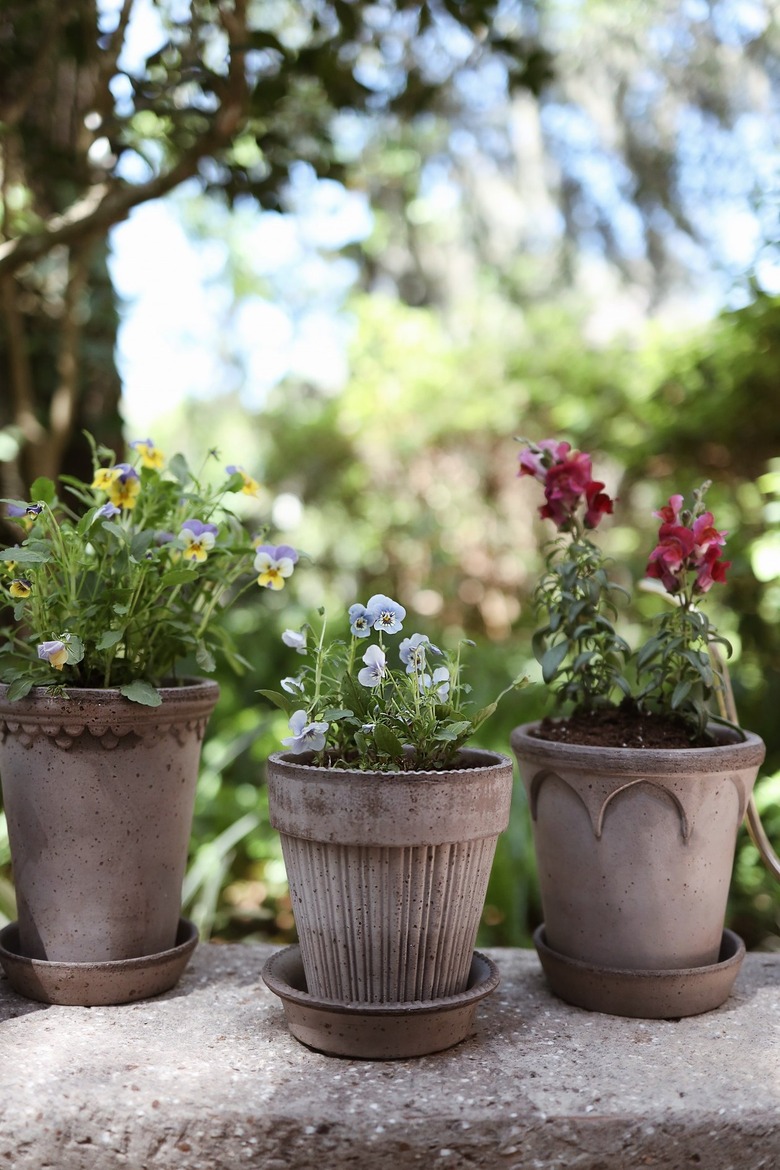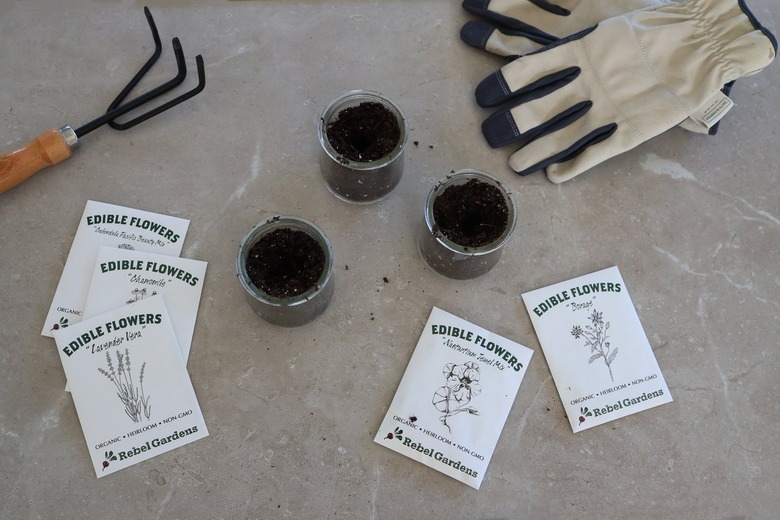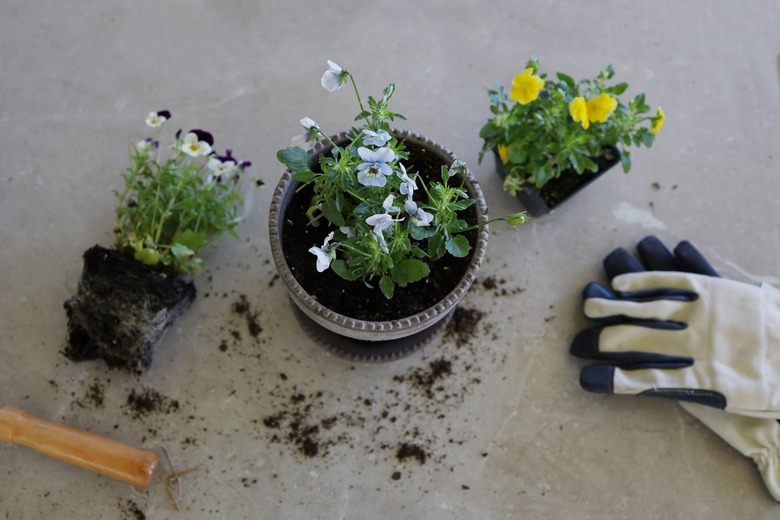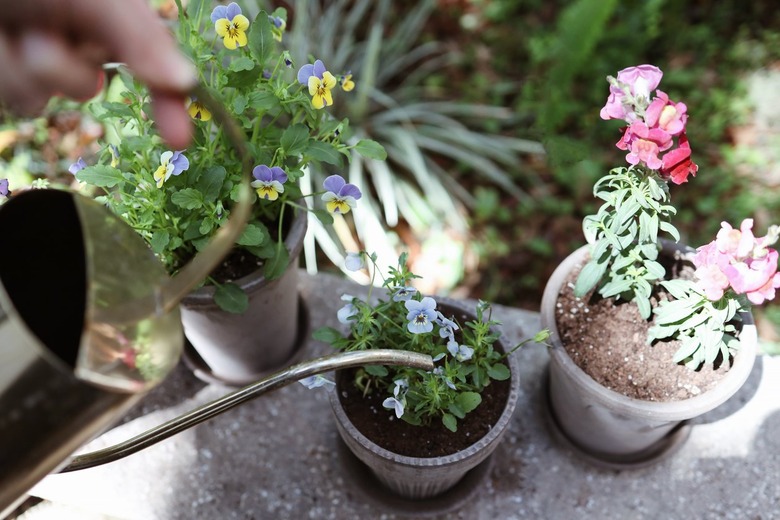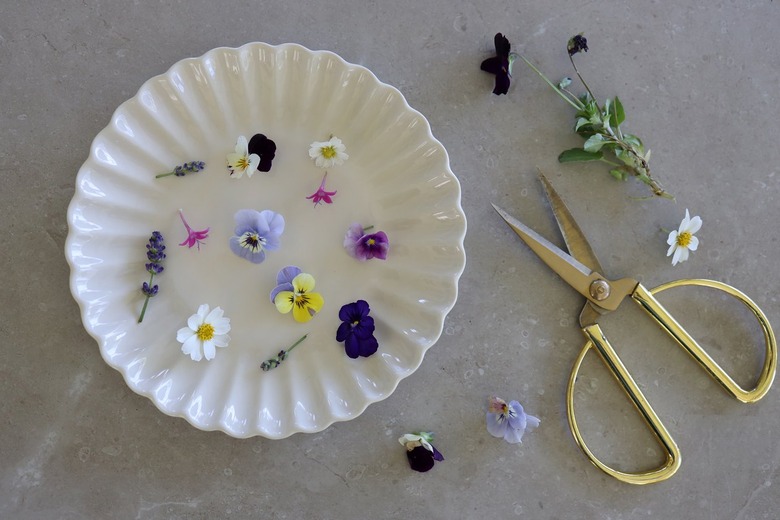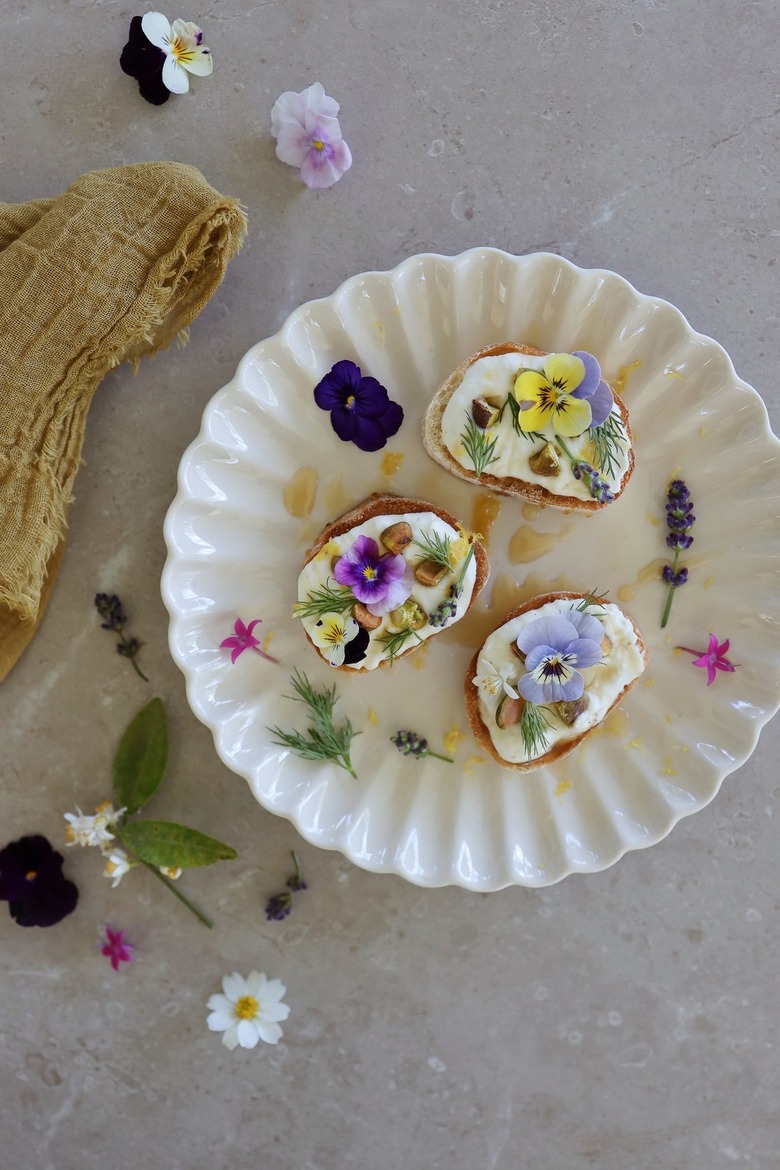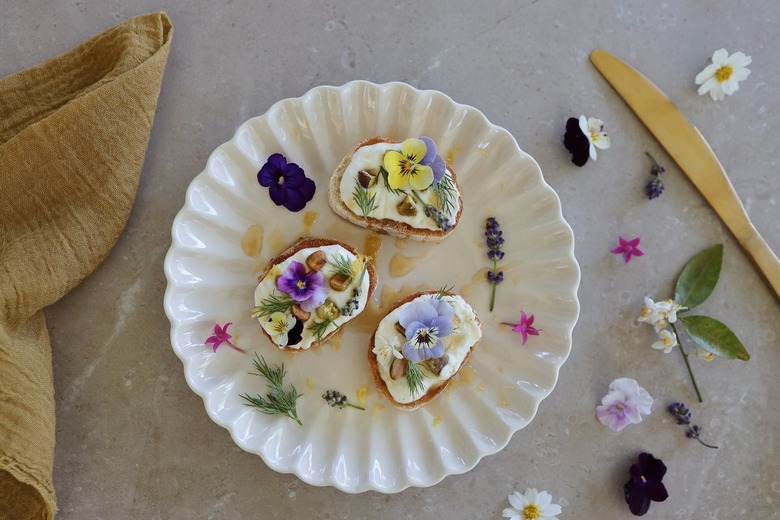DIY Edible Flower Garden (With A Whipped Feta Recipe)
We may receive a commission on purchases made from links.
Flowers are easy on the eyes, but they can also be a delight for the palate. (Yes, really.) In fact, florals have been used in gastronomy dating back to the ancient ages. Their colorful hues brighten up any dish, but they are particularly delicious in salads, sauces, desserts, and cocktails. While adding flowers to your food may be a fun way to spice things up in the kitchen, finding them in stores can be somewhat of a chore. So we decided to grow our own DIY potted edible flower garden — and we're sharing how you can, too. It's such a beautiful addition to your patio landscaping or for a different take on a kitchen garden. Don't miss the tasty (and eye-pleasing) whipped feta recipe at the end!
Things Needed
-
Edible flower seeds or live organic plants
-
Seed starter trays or empty egg/yogurt cartons
Types of Edible Flowers
Types of Edible Flowers
You might be surprised to learn that some of your favorite flowers from the garden are actually edible, many even offering nutritional and medicinal benefits. For example, roses and nasturtiums are high in vitamins A and C, while lavender and chamomile are commonly used to ease anxiety and promote sleep.
Not just gorgeous garnishes, edible flowers can also add lovely aromatics and a wide range of flavors to your dishes, ranging from botanical and herbaceous to peppery and zesty. Try them in soups, on cupcakes, in ice cream, and sprinkled on vegetables. Below is a list of edible flowers commonly used for culinary purposes:
- Viola/pansy
- Marigold/calendula
- Lavender
- Rose
- Chamomile
- Daisy
- Nasturtium
- Snapdragon
- Honeysuckle
- Dianthus
- Borage
- Hibiscus
- Lilac
- Elderflower
- Peonies
- Bachelor's button
- Chrysanthemum
- Sunflower
- Violet
- Citrus blossom
- Dandelion
- Chive blossom
- Squash blossom
While many flowers are edible, it's important to note there are also a good deal that are not edible. Some of these include: anemone, azaleas, belladonnas, daffodils, dahlias, foxglove, holly, hydrangea, lily, oleander, and sweet peas. A good rule of thumb: If you are ever unsure whether a flower is edible, don't eat it.
Also, you should only eat organic flowers that have not been sprayed with pesticides, herbicides, or any other chemicals. Keep in mind that flowers from nurseries, garden centers, or florists are usually treated with toxic chemicals and should not be consumed.
Starting Edible Flowers from Seed
Starting Edible Flowers from Seed
If you'd like to start growing edible flowers from seed, you can either sow them directly into the ground or start them indoors. Follow the directions on the seed packets for sowing seeds in the ground — there will be specific guidance for each flower type regarding seeding depth and spacing.
To start seeds indoors, you can either use seed starter trays, empty egg cartons or yogurt cups, or small planter pots. Fill the containers with organic potting soil, leaving about an inch of space at the top. (Note: you could also use organic seed starting soil— the important point is that the soil be organic and not treated with any chemicals.)
Make a shallow hole in the center of the soil with your finger, and sprinkle two to three seeds into the hole. Cover gently with soil, mist with water until the soil is damp, and loosely cover the pot with plastic wrap to maintain humidity. Be sure to label the seeds if you're planting several different types.
Place the seeds in a warm spot that's not in direct sunlight (or put them on a heating mat). Once the seeds sprout, remove the plastic wrap, and place them in a sunny window sill. Keep the top layer of soil moist but not soggy. Let them grow until they are about two inches tall and have sprouted a second set of leaves.
Planting Edible Flowers in Pots
Planting Edible Flowers in Pots
To transplant your seedlings to bigger pots that will live outdoors, wait until all chance of frost has passed. Then it's time to harden the seedlings off by exposing them to a covered area outdoors for an hour or two, increasing their exposure each day until they can stay outdoors all day. If you have several seedlings growing close together in the same container, select the healthiest one and remove the others.
Be sure to choose planter pots that are big enough to give the seedlings plenty of room to grow and have drainage holes on the bottom. If you'd like to add better drainage, you can add a 1-inch layer of rocks or pebbles to the bottom of the pot. Fill the pots 2/3 full with organic potting soil, and dig a well slightly wider than the seedling's root ball. Use a butter knife to gently ease the seedlings from their starter containers, delicately handling them by their leaves, not their stems, and plant them in the new pots at the same depth as the starter containers.
If you opt to buy already-established edible flowers instead of growing them from seed, make sure they were grown organically and not sprayed with any chemicals. Remove the flowers from their original containers, gently loosen the roots, and plant them in the new pots. Water gently. If you'd like to plant a combination of different edible flowers in the same pot, pair ones that have similar sunlight and water needs.
Maintaining an Edible Flower Garden
Maintaining an Edible Flower Garden
Edible flowers are similar to most flowering plants in that they love lots of sunlight, so make sure to place your pots in a location that gets a minimum of six to eight hours of sunlight per day. It's also worth noting that some flowers will have a much shorter growing season than others, so you may want to choose particular flower types that will thrive in your particular gardening zone.
For the first week after planting, water daily to keep the soil moist but not overly wet. Afterwards, water once or twice a week, or whenever the top few inches of soil feels dry to the touch. Remove spent or wilted blossoms weekly to encourage more blooms and new growth (this is called "deadheading").
As your flowers grow, they will consume a lot of nutrients from the soil, so you'll need to fertilize every two weeks. Only use organic fertilizers that are labeled for vegetable or edible plant use. For pest control, hand pick any visible pests off of the flowers, or cover them with nets. You can also use companion gardening as a means of deterring pests. For example, chamomile attracts ladybugs, which eat aphids — and marigolds attract hover flies, which eat caterpillars. Never use a pesticide designed for ornamental flowers.
Harvesting Edible Flowers
Harvesting Edible Flowers
It's best to harvest edible flowers in the morning, right after they have fully opened. Look for flowers that are at their peak color. Only the flower petals should be consumed, so be sure to remove the stamen and pistils.
Gently submerge the flowers in a bowl of cold water to clean off any dirt, excess pollen, or insects. Place them gently on a paper towel to air dry (don't pat them to dry or you'll risk flattening or crushing the petals). It's best to use edible flowers right away, but you can place them between damp paper towels and store them in an airtight container in the refrigerator for about a week.
Aside from gorgeous garnishes, edible flowers can be used to flavor syrups, frozen inside ice cubes, infused into teas, and much more. Below is an easy recipe to get you started with using edible flowers in your cooking!
Whipped Feta Crostini with Edible Flowers
Whipped Feta Crostini with Edible Flowers
Ingredients:
- French baguette
- 8-ounce block of feta cheese
- 1/2 cup plain Greek yogurt
- 1 tablespoon lemon juice
- 1 garlic clove, minced
- 1 teaspoon dried culinary lavender*
- Chopped roasted pistachios
- Honey for drizzling
- Flaky salt + fresh cracked pepper (to taste)
- Lemon zest for garnish
- Fresh dill for garnish
- Edible flowers for garnish
Directions:
Slice the baguette into 1-inch thick pieces and toast in a toaster (or oven). Place the toasted baguette slices on a serving plate or platter and set aside. Put the feta cheese, Greek yogurt, lemon juice, garlic, and dried lavender in the bowl of a food processor. Blend until the mixture is thoroughly combined and creamy. Spread a generous spoonful of whipped feta dip onto each toasted baguette slice. Drizzle honey over the top and season with salt and pepper. Garnish each piece of crostini with chopped pistachios, lemon zest, sprigs of fresh dill, and any of your own edible flowers (we used pansies, lavender, and citrus blossoms). A gorgeous and tasty appetizer whenever you want to impress guests!
Tip
*To dry your own lavender, pick the stems when the buds are on the smaller side. Bundle about 20 stems together with a string or rubber band, and hang them up upside down for about two weeks until dry. (Try this DIY hanging herb dryer!) Pull the buds apart to create lavender granules, and store in an airtight container.
